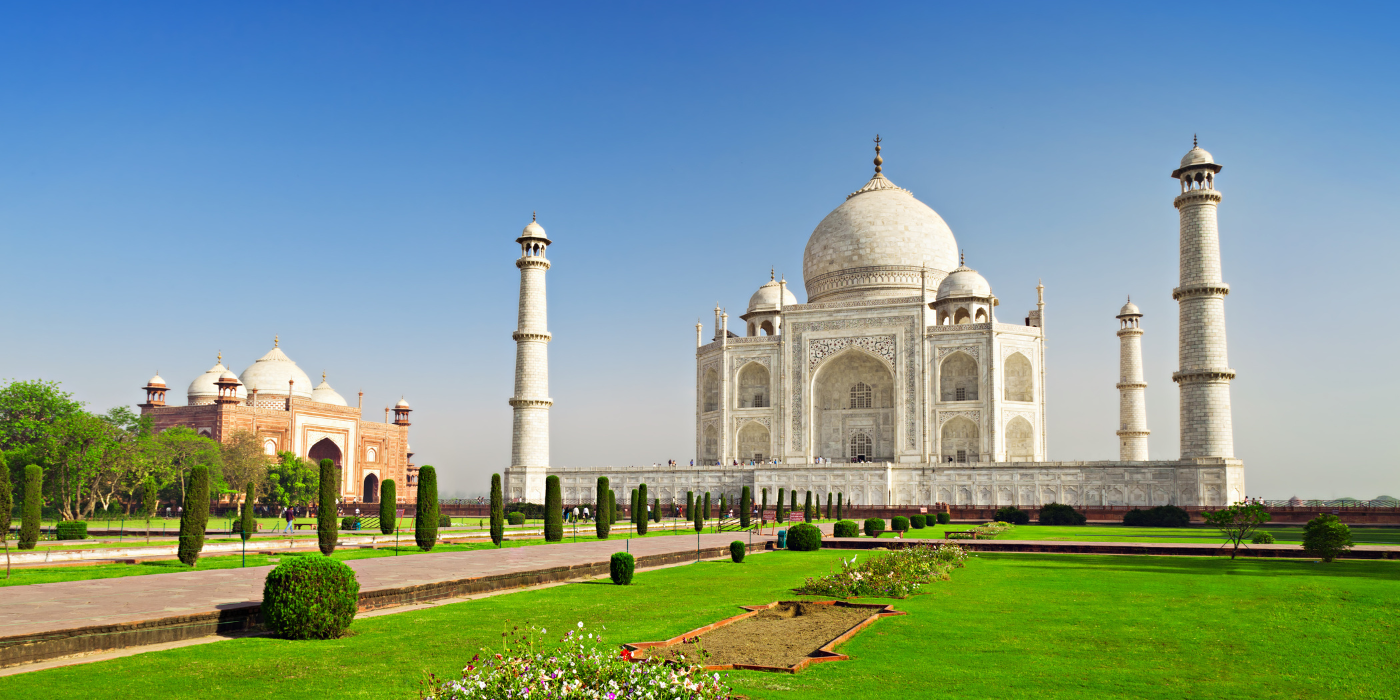
Top 20 Best Places to Visit in Agra in 2024
Best Places to Visit in Agra : Agra isn’t just about the Taj Mahal; it’s a destination brimming with historical richness and diverse sightseeing opportunities. Beyond the iconic monument lies a world of Mughal-era buildings, forts, and monuments that hold significant historical value. Whether within the city or its surrounding areas, Agra offers a plethora of attractions that contribute to a truly enriching tour experience. As part of the Golden Triangle alongside Delhi and Jaipur, Agra blends its deep-rooted historical fervor with modern touches, promising a captivating journey through time and culture.
1. Agra Red Fort

Recognized as a UNESCO World Heritage Site, the Agra Red Fort stands as an illustrious testament to the grandeur of the bygone Mughal Empire. Spanning an expansive area of 3,80,000 square meters, Emperor Akbar commissioned its construction in 1556, later adorning it with red sandstone during renovations in 1573. Situated 2.2 kilometers from Agra, this formidable fortress boasts 70-foot-high fortified walls on all sides. Exploring the Agra Fort ranks among the top activities for visitors to the city.
Dubbed the “Walled City,” Agra Fort features four gates, with the Delhi Gate and the Lahore Gate being the most renowned. Within its walls lie numerous palaces, including the opulent Shish Mahal and Khaas Mahal. Noteworthy structures like the reception halls Diwan-i-Khas and Diwan-i-Aam, as well as historic mosques like the Moti Masjid and Nagina Masjid, add to the fort’s allure, making it a must-visit destination.
2. Fatehpur Sikri
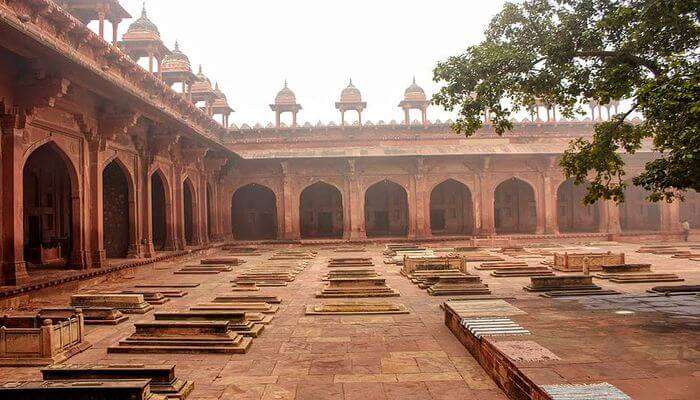
Fatehpur Sikri emerges as an essential stop on any Agra itinerary, steeped in historical significance as the former capital of several Mughal Emperors, notably Akbar. Originally a dilapidated village, Sikri transformed into its present-day status following Emperor Akbar’s victory over Gujarat in 1573, commemorated by its renaming.
Nestled on a rocky ridge spanning 3 kilometers in length and 1 kilometer in width, Fatehpur Sikri showcases a harmonious blend of Persian, Indian, and Islamic architectural styles. Constructed predominantly from locally quarried red sandstone, the town boasts seven imposing gates encircling a 6-kilometer boundary wall. Recognizing its cultural importance, UNESCO bestowed World Heritage status upon Fatehpur Sikri, solidifying its position as a top tourist destination in Agra, offering visitors an immersive journey through time and culture.
3. Jama Masjid

No tour of Agra would be complete without a visit to the Jama Masjid. While it serves as a religious center, its architectural grandeur and impressive scale make it a captivating destination for all. With four towering minarets and the capacity to accommodate up to 25,000 worshippers at once, this mosque boasts three grand gateways and shares an awe-inspiring view with the nearby Agra Red Fort.
The Jama Masjid’s soaring dome, majestic archways, and intricate red sandstone detailing create an enchanting atmosphere. Designated as a UNESCO World Heritage Site, its golden inscriptions set against a royal blue backdrop add to its allure, making it an essential stop for visitors. Known colloquially as the “Friday Mosque,” this 17th-century marvel stands as a testament to Agra’s rich architectural heritage.
4. Moti Masjid

Speaking of mosques, the Moti Masjid stands out as another must-see attraction in Agra. This renowned monument, built by Mughal Emperor Shah Jahan, is celebrated for its architectural splendor and is not to be overlooked. Dubbed the Pearl Masjid for its pristine white exterior, which gleams like a pearl in the sunlight, the Moti Masjid was commissioned exclusively for the Royal Court.
Step inside, and you’ll be greeted by resplendent white interiors, with a marble tank serving as a focal point in the courtyard. A marble sundial stands as a testament to the architectural prowess of bygone eras. Numerous archways lead to the spacious prayer hall, while the main entrance faces eastward. The Moti Masjid offers a picturesque view of the Yamuna River from its precincts, adding to its charm and allure.
5. Sikandra Fort

Sikandra Fort stands as a paramount historical site and a must-visit destination in Agra. Constructed from deep red sandstone, this magnificent structure is renowned for its timeless architectural splendor, offering a glimpse into the illustrious past of the region. Situated in the locality of Sikandra, the fort serves as the mausoleum of Emperor Akbar, a testament to his enduring legacy.
Set amidst verdant gardens, the fort exudes grandeur, surrounded by towering walls that enclose the serene landscape. The meticulously landscaped gardens, divided into four sections, reflect the horticultural practices of the era, enhanced by the presence of ornate fountains. Emperor Akbar’s personal oversight is evident in the fort’s meticulous design, featuring five levels adorned with intricate carvings adorning its walls. Sikandra Fort stands as a well-preserved monument, offering visitors an unforgettable experience and solidifying its status as one of Agra’s premier attractions not to be missed.
6. Itmad-Ud-Daulah’s Tomb
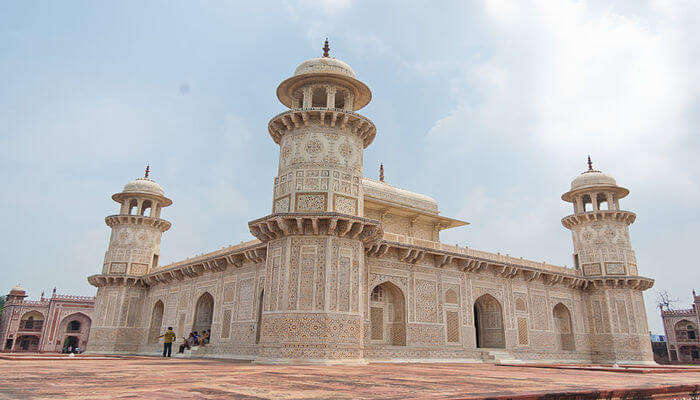
The mausoleum of Itmad-ud-Daulah, situated in Agra, stands as a marvel of architectural brilliance, second only to the renowned Taj Mahal. Its intricate carvings and masterful inlays are a sight to behold, earning it the moniker “Baccha Taj” or the “Baby Taj,” often regarded as a precursor to the Taj Mahal itself. Crafted from red sandstone, this tomb is a must-visit destination near the Taj Mahal, enriching any traveler’s itinerary.
Perched on the banks of the Yamuna River, the pure white facade of Itmad-ud-Daulah’s Tomb epitomizes the elegance of Islamic architecture and design. The meticulously sculpted arches, graceful minarets, elaborate floral motifs, and expert use of marble to enhance its beauty showcase the epitome of artistic mastery. A visit to this architectural gem offers a captivating journey through the Islamic architectural style and leaves visitors spellbound by its exquisite craftsmanship.
7. Jodha Bai Ka Rauza
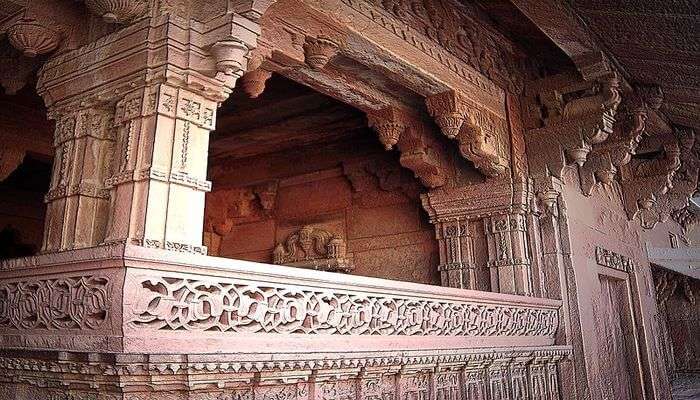
Also known as Jodha Bai’s Palace, this residence served as the dwelling for Emperor Akbar’s first Rajput consort. Nestled near the Jahangiri Mahal, Jodha Bai’s Palace exudes simplicity and sophistication, exemplifying the Indo-Mughal architectural style with influences from Gujarat and Gwalior.
Located approximately 6 kilometers from the Agra Fort, the palace offers a serene ambiance, complemented by intricate details and fine craftsmanship. Within its walls, visitors can catch glimpses of the Taj Mahal through delicately crafted slits, adding to its allure. Situated in the Fatehpur Sikri area, this palace stands as a testament to Emperor Akbar’s religious tolerance, featuring a myriad of mural designs depicting symbols from both Hindu and Islamic traditions, including lotus flowers, elephants, and peacocks, symbolizing unity and harmony between the two religions.
8. Mehtab Bagh
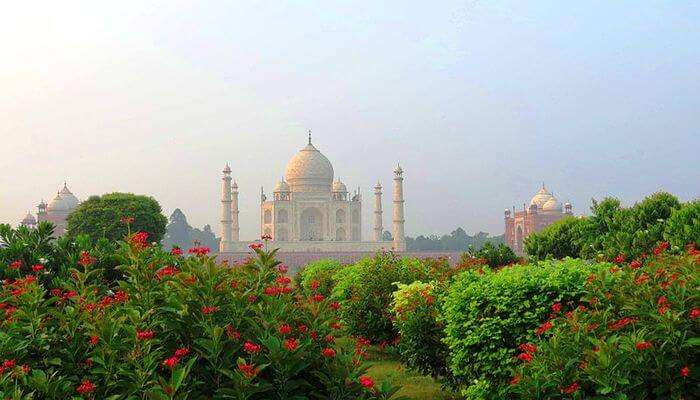
Positioned north of both the Taj Mahal and the Agra Fort, Mehtab Bagh stands as a picturesque square garden complex nestled along the banks of the Yamuna River. Its strategic location offers a harmonious alignment with the Taj Mahal, presenting a captivating setting for photographers, especially during sunset. This enchanting spot ranks among the top evening destinations in Agra, drawing travelers year-round.
The garden’s charm is accentuated by four towers positioned at each corner of an octagonal tank, creating a symmetrical oasis. On moonlit nights, the Taj Mahal’s reflection in the tank mesmerizes visitors, adding to the allure of the garden. Bursting with blooming flowers, medicinal herbs, and fruit-bearing trees, Mehtab Bagh epitomizes Mughal architecture, boasting a layout of four distinct gardens. Additionally, a large water tank to the east ensures adequate irrigation throughout the area, enhancing its lush beauty.
9. Traditional Bazaars

No exploration of Agra would be truly complete without delving into its vibrant shopping scene. The city’s traditional bazaars offer an array of treasures, from rare artifacts to exquisite handicrafts and memorable souvenirs. Among the must-have items is the popular marble replica of the Taj Mahal, a beloved keepsake for many visitors.
Agra boasts several bustling markets, including Subhash Bazaar, Kinari Bazaar, Raja ki Mandi, and Sadar Bazaar, each with its unique charm. However, Sadar Bazaar stands out as a highlight, particularly in the evening. Here, visitors are treated to a dazzling array of leather goods, handicrafts, and garments, making it a shopper’s paradise. Don’t miss the opportunity to indulge in Agra’s famous street food, adding a flavorful touch to your shopping excursion.
10. Taj Mahal

Here we are, at last! Arriving at the pinnacle of Agra’s attractions—the iconic Taj Mahal. For many, tours to this breathtaking monument serve as the main highlight, and with good reason. As one of the Seven Wonders of the World and a masterpiece of Mughal architecture, it stands as a testament to Shah Jahan’s enduring love for his beloved wife, Arjumand Bano Begum.
Crafted entirely from white marble, both the interior and exterior of the Taj Mahal showcase exquisite design and craftsmanship. The interior chamber, shaped like an octagon, is adorned with intricate inlays of precious gems, reflecting opulence and grandeur. Surrounding this marvel, lush gardens provide a serene backdrop, offering a refreshing oasis of greenery and tranquility. With its unparalleled beauty and timeless allure, the Taj Mahal rightfully claims its place among India’s most revered historical landmarks.
11. Chini Ka Rauza
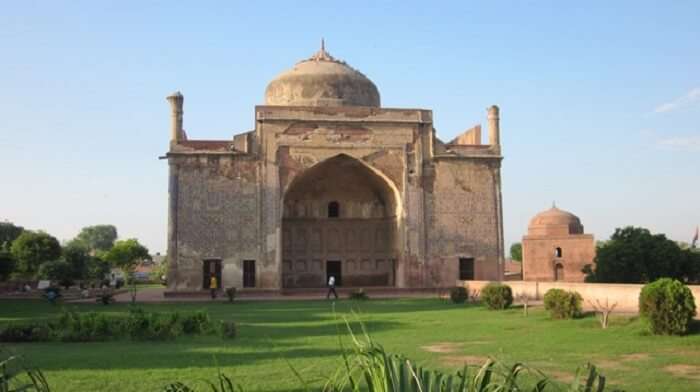
Chini ka Rauza is another one of the places to see in Agra if you are visiting Itimad-ud-Daulah Tomb. The tomb is dedicated to Allama Afzal Khan Mullah who used to be a famous Persian scholar and poet during Jahangir’s reign. He was later promoted to wazir. Built in 1635 A.D., the tomb is an example of Indo-Persian architecture. The central chamber is in octagonal shape and the structure is glazed with tile works. Overlooking Yamuna River, the tomb is set in picturesque settings.
12. Akbar’s Tomb

Constructed between 1605 and 1613, Akbar’s Tomb serves as the final resting place of the esteemed Emperor Akbar. Situated in Sikandra, this grand mausoleum was commissioned by Akbar himself during his lifetime, reflecting his foresight and reverence for his own legacy. Despite the plundering of its treasures by Aurangzeb’s army, including gold, silver, and jewels, the tomb remains a striking testament to Akbar’s enduring influence.
Accessed through the southern gateway, visitors are greeted by a sprawling garden meticulously arranged in the Charbagh style, evoking a sense of serenity and grandeur. Despite the passage of time and the vicissitudes of history, Akbar’s Tomb continues to captivate visitors, standing as one of Agra’s most magnificent tourist attractions.
13. Anguri Bagh

Nestled within the grounds of the Agra Fort lies Anguri Bagh, a cherished destination among Agra’s array of tourist spots. These opulent gardens, crafted in 1637, were meticulously designed to offer Shah Jahan a serene retreat for leisurely evening strolls. Reflecting the Charbagh style, characterized by its symmetrical layout and intricate geometric patterns, Anguri Bagh is a testament to the artistry of Mughal landscaping.
In its heyday, this garden flourished with the cultivation of luscious grapes, renowned for their juiciness and quality. These grapes were utilized in crafting wine fit for an emperor, showcasing Shah Jahan’s refined palate and appreciation for the finer things in life. Today, Anguri Bagh stands as a testament to the grandeur and sophistication of the Mughal era, inviting visitors to step back in time and immerse themselves in its timeless beauty.
14. Machhi Bhawan
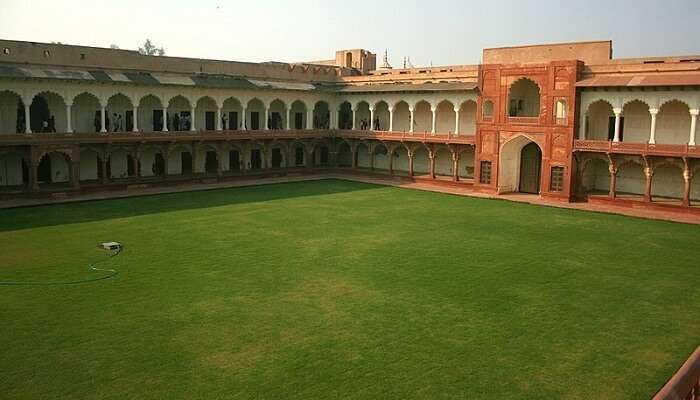
Macchi Bhawan stands tall as a two-story structure ensconced within a picturesque garden, distinguished by its graceful arched galleries. Its name derives from the ornate marble tanks and fountains within, once home to shimmering gold and silver fish. Once serving as Shah Jahan’s opulent throne, affording him a panoramic view of his court, it remains a must-see destination in Agra. Situated opposite the Diwan-i-Aam within the Agra Fort, it beckons visitors to explore its historical grandeur.
15. Diwan-I-Aam

As its name implies, Diwan-i-Aam once served as the venue for general assemblies and public gatherings, where Shah Jahan would attentively listen to the grievances of the common people. This grand hall, initially crafted from red sandstone, is partitioned into three distinct sections. The emperor’s throne was secluded from the courtiers by ornate golden railing at the front and silver railings on the remaining sides. The formal ceremony of the emperor addressing the audience was known as Jharokha Darshan.
16. Khas Mahal
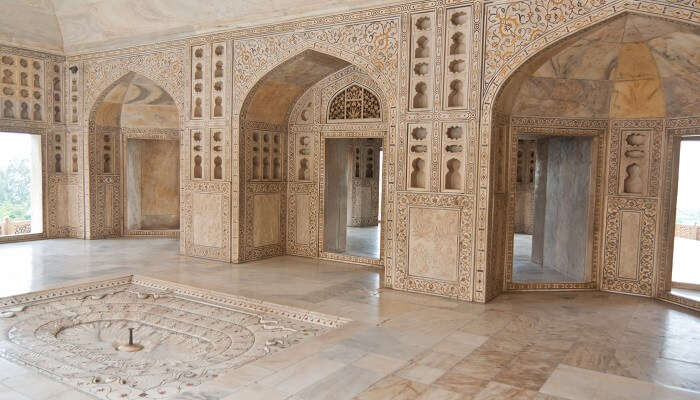
True to its name, Khas Mahal was commissioned by the emperor as a residence for his daughters, Roshnara and Jahanara. Its opulent ceilings and intricately designed alcoves are a delight to behold, explaining the nine years it took to construct this lavish private palace. Situated between the Yamuna River and the Anguri Bagh, Khas Mahal offers a serene ambiance and breathtaking vistas. Wander around this majestic structure to fully appreciate its stunning architecture and captivating surroundings.
17. Diwan-I-Khas
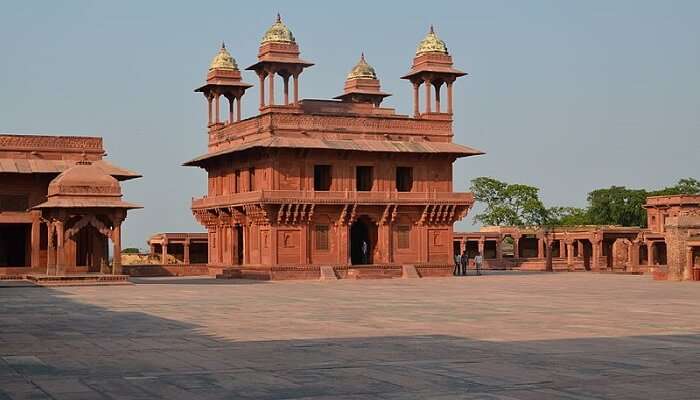
Indeed, Shah Jahan reserved a secluded enclave, known as the Iwan-i-Khas, for hosting esteemed guests such as kings, ambassadors, and nobles. Positioned at the rear of Macchi Bhawan, this distinguished area once housed the renowned Takht-i-Taus, or Peacock Throne, before its relocation to the Red Fort in Delhi. Within the hall, intricate Persian inscriptions adorn the black stone, adding to its allure and historical significance.
18. Nagina Masjid
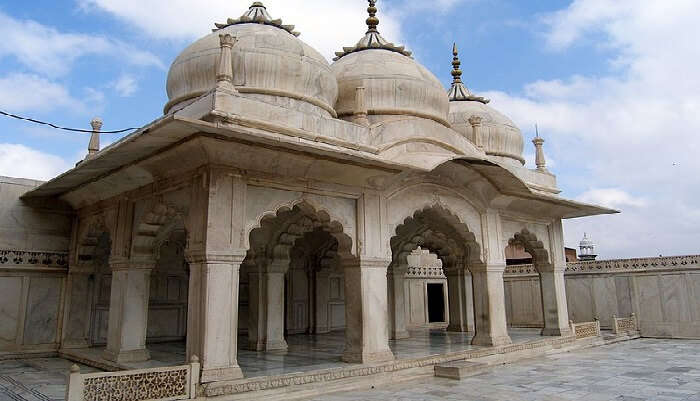
Nagina Masjid, a stunning gem of Agra, was commissioned by Shah Jahan between 1631 and 1640 AD exclusively for the royal women. Crafted from pristine white marble, this private mosque boasts elegant architecture and tasteful ornamentation. Noteworthy for its graceful arches and magnificent domes, it exudes an air of serenity and beauty. The prayer chamber is situated on the western side of this secluded sanctuary, offering a tranquil space for devotion and reflection.
19. Mariam-Uz-Zamani Tomb

Mariam-uz-Zamani, a renowned Agra attraction, houses the mausoleum of Jodha Bai, also known by various names in history. Positioned on the western periphery of Akbar’s Tomb, this memorial was erected by Jahangir as a tribute to his beloved mother. Crafted from striking red sandstone and enveloped by opulent Mughal gardens, the tomb offers a breathtaking sight. Its serene ambiance and historical significance make it a must-visit destination in Agra, captivating visitors with its beauty and rich heritage.
20. Radha Soami Samadhi

Standing as an iconic landmark in Agra, the magnificent structure of Radha Soami Samadhi commands attention. Revered as one of the holiest sites for followers of the Radha Soami faith, this temple is distinguished by its grand central dome and encircling pillars. Serving as the mausoleum of Huzur Swamiji Maharaj, the founder of the Radha Soami faith, it holds immense spiritual significance. Remarkably, the temple’s construction commenced in 1904 and spanned a century, a testament to its enduring legacy and meticulous craftsmanship.

One thought on “Top 20 Best Places to Visit in Agra in 2024”